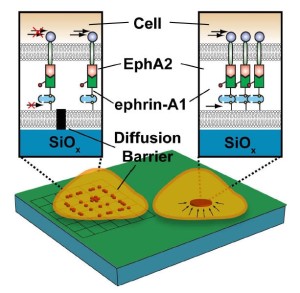APPLICATIONS OF TECHNOLOGY:
- Drug design and testing
- Diagnosis and treatment of cancer and other diseases
ADVANTAGES:
- Can be applied to living cells from biopsies
- Compatible with samples as small as a single cell
- May be scaled up to test multiple drugs simultaneously
- Analyzes phenotype rather than gene or protein expression
- Mimics and assesses receptor-ligand behavior at cell-cell contacts
ABSTRACT:
Jay Groves, Joe Gray and their colleagues at Berkeley Lab have developed a phenotypic cell marker that can identify metastatic cells. The researchers created an assay in which a live cell, with an intact membrane that contains receptors, is placed on top of a synthetic membrane that is deposited on a glass slide and contains ligands (see figure).

A schematic of the invention. As seen in the magnified insets, a lower membrane with attached ephrin-A1 molecules (i.e., ligands) is attached to a glass (SiOx) slide. A cell with ephrin type-A2 membrane receptors (EphA2) is placed on top of the lower membrane. On the right side, the resulting receptor-ligand complexes are radially transported (arrows) to the center of the contact interface, forming an Eph-ephrin assembly that can be detected with a microscope. On the left side, nanoscale metal barriers (black), deposited before formation of the synthetic membrane, block the lateral (or radial) transport of receptor-ligand complexes.
The researchers tested cells with ephrin type-A2 receptors, which are highly expressed in malignant tumors. When the corresponding ligands on the synthetic membrane bound to these receptors, the receptor-ligand complexes were transported towards the center of the interface between the cell membrane and synthetic membrane. This quantifiable “radial transport” phenotype correlated strongly with and could act as a marker for tumor invasiveness (Pearson’s correlation coefficient = 0.91, p = 7.5×10-8).
A novel feature of the assay is the characterization of a cell behavior in a setting that mimics cell-to-cell interaction and allows lateral movement (diffusion and transport) of receptors and ligands. If desired, a nanoscale metal grid can be placed on the slide to confine lateral mobility within the lower membrane to precisely defined corrals.
When the researchers tested 26 human breast cancer cell lines, they found that radial transport correlated not only with tumor invasiveness but also with the expression levels of certain proteins. When metal grids were used to mechanically block radial transport, protein expression and recruitment were correspondingly altered. The correlations between these phenomena—radial transport, protein expression, protein recruitment, and tumor invasiveness—suggest that chemical agents that block any of the first three may also block the last and be used to treat cancer. The invention could also be used to assess receptor-ligand behavior in cells that are healthy or affected by other diseases.
Unlike existing tests for cancer cell markers that measure protein or gene expression and require large samples, this live cell assay can be applied to single cells, including those from biopsies or cell aspirates. Moreover, the assay can be scaled up and applied to different receptor-ligand combinations to do the following: test new drugs that target different receptors; diagnose tumors; choose the most effective medication from existing therapies; and make prognoses.
DEVELOPMENT STAGE: Bench scale prototype.
STATUS: Patent pending. Available for licensing or collaborative research.
SEE THESE OTHER BERKELEY LAB TECHNOLOGIES IN THIS FIELD:
Membrane-Derivatized Colloids for the Detection and Analysis of Cell Membrane Binding Interactions, IB-1919
SATB1: A Fundamental Prognostic Marker and Therapeutic Target for Metastatic Breast Cancer, IB-2186
REFERENCE NUMBER: IB-2640